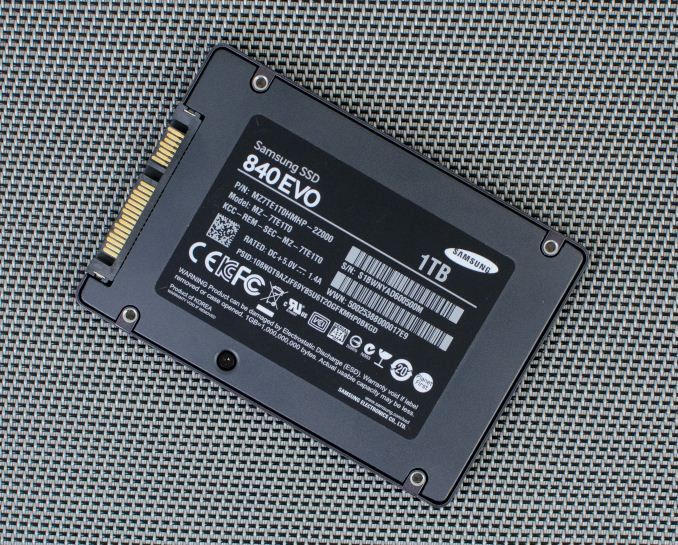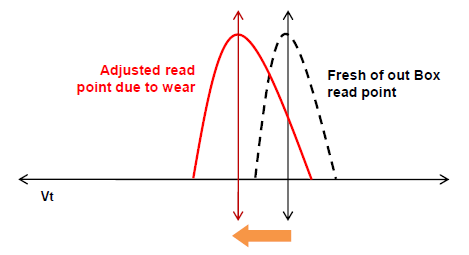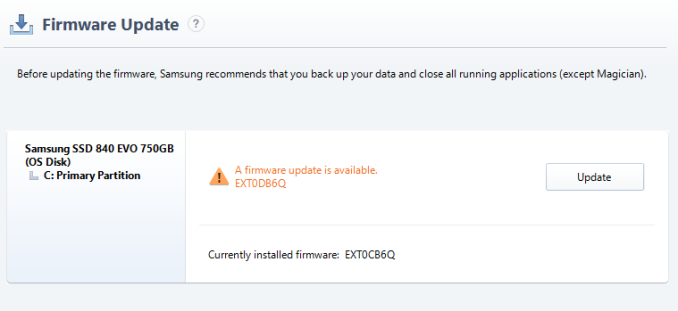Samsung Releases Second 840 EVO Performance Fix
by Ryan Smith on April 27, 2015 6:00 PM EST
If nothing else, the odyssey of Samsung’s 840 EVO has not been lacking in excitement. After initially launching in 2013 to great fanfare as an excellent, strong-performing low-cost drive, over the long run performance regressions began to occur in deployed drives that saw the read performance of old data significantly drop. At the heart of the issue was the drive’s relatively uncommon 19nm TLC NAND, which given the combination of small feature size and tighter requirements of TLC, eventually resulted in the drive having to slow down and re-read cells to properly read the charge-decayed cells.
Aiming to fix the issue, in 2014 Samsung released a performance restoration tool and firmware update for the 840 EVO. The combination of the tool and firmware would update the drive to better handle decayed cells and reduce the need to re-read them, meanwhile the restoration tool would refresh the drive’s data by re-writing all of the data to fresh cells. The idea being that fresh data in combination with the newer firmware would prevent the drive’s performance from decaying again.
Unfortunately that didn’t work out as planned, and while the data refresh from the performance restoration tool did bring drive performance back up, over the long run performance once again began decaying on old data, even with the firmware improvements. As a result Samsung has commissioned a second, more permanent fix for the 840 EVO. This fix involves another firmware update, this time installing a firmware that periodically refreshes old data rather than the one-off refresh of the performance restoration tool. Refreshing the data once again brings performance back up to where it should be, and the periodic, repeating nature of the refresh means that data is never allowed to get too old to let performance degrade again.
Ultimately Samsung’s second fix is a bit of a brute force solution to the problem, but at this point there doesn’t seem to be anything Samsung can do about 19nm TLC cell charge decay other than to refresh the data, as the problem is intrinsic to the NAND itself. Pre-release versions of the firmware show that this fix works, and conceptually this is much more likely to work over the long run than Samsung’s initial fix. The tradeoff is that it does consume P/E cycles to refresh the data, but by our own calculations even 5 years of refreshes at 1/week would only be 26% of the drive’s rated 1000 cycle lifetime. Meanwhile for the longer term, Samsung has since moved on to 3D-VNAND in newer drives, which is more stable than very small geometry planar NAND and essentially turns back the clock on NAND scaling issues. So the 840 EVO should be the last Samsung TLC drive to encounter this issue.
In any case, after previewing the updated firmware to the press, Samsung has released the updated firmware and its associated version of Samsung Magician (version 4.6) to the public over on their website. After an initial staggered release over the weekend – we suspect to make sure not too many users had the firmware if a problem quickly cropped up – Samsung looks to have opened downloads to everyone. However Mac and Linux users will want to note that at this time only the Magician version of the firmware has been released; the bootable ISOs for directly updating the drive have yet to be updated.
In the meantime this will continue to be an issue we keep an eye on. As with the initial problem and Samsung’s first fix, the decay issue only occurs after a time, so we’ll have to see where 840 EVO performance is in a couple months’ time. However with the very nature of the problem and the periodic refreshing of data, we’re hopeful that this will finally put an end to the performance degradation.
Source: Samsung












73 Comments
View All Comments
A5 - Monday, April 27, 2015 - link
You're not going to get that.Unless you want to spend a crap ton of money using Samsung, anyway.
chizow - Monday, April 27, 2015 - link
I updated my 4xEVO array without any problems, a little trick for those who are doing multiple, you can upgrade 1 drive's firmware, and while it is counting down from 20s, just kill Magician in your Task Tray, re-open it, and update another drive. Do that for each of your drives, then shut down, and they should all have updated np.ssdengr - Monday, April 27, 2015 - link
Unfortunately, they can't do the correct solution by just changing the read threshold because Intel has it patented. http://www.google.com/patents/US20120254699theduckofdeath - Wednesday, April 29, 2015 - link
Maybe you should have read the "referenced by" section before posting this?SigmundEXactos - Tuesday, April 28, 2015 - link
What about the 840 non-EVO? I have one lying around that I plan to stick in a new HTPC. Will this fix apply to that drive as well?hojnikb - Tuesday, April 28, 2015 - link
nopeMrSpadge - Tuesday, April 28, 2015 - link
AT should "torture" Samsung about the vanilla 840 every time they speak with them. And if nothing happens: point out this customer care failure when ever a new Samsung product is discussed.madwolfa - Tuesday, April 28, 2015 - link
Is 840 affected as well? I have one in my desktop...Martin84a - Tuesday, April 28, 2015 - link
Unfortunately yes. Samsung also acknowledged it on the German Samsung site, however there is no news about any fix.nevcairiel - Tuesday, April 28, 2015 - link
Still no news about any plans for an update for the mSATA 840 EVOs. It clearly suffers from the same issues, but there is no firmware update, nor a manual fix option in the latest Magician.